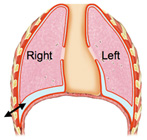IPHY 3410
Instructor: Dr. Leif Saul
Fall 2023

IPHY 3410Instructor: Dr. Leif Saul
|
 |
1. In the jejunum, an amino acid moves from the lumen into the epithelium; afterwards, it passes through _____ on its way to the liver.
a. Hepatic portal vein
b. Mesentery
c. Ileum
d. a and b
e. All of the above
2. Bile is found in which liver structure(s)?
a. Hepatic portal vein
b. Liver sinusoids
c. Central vein
d. None of the above
e. a and b
3. A few minutes after eating a large scoop of ice cream, your blood sugar will be highest in which blood vessel(s)?
a. Hepatic portal vein
b. Hepatic artery
c. Central vein
d. All of the above are equally high in blood sugar
e. a and b
4. A carbon dioxide molecule in the blood within a lung randomly bounces around due to thermal energy until it is inside the air space in the lung. This is an example of:
a. Internal respiration
b. External respiration
c. Gas transport via the blood
d. Ventilation
e. None of the above
5. The major type(s) of epithelial lining in the respiratory system is/are:
a. Simple squamous epithelium
b. Stratified squamous epithelium
c. Pseudostratified ciliated columnar epithelium
d. a and c
e. All of the above
6. A person who can inhale a plastic spoon into a bronchus probably has, in comparison to other people,
a. Narrower bronchi
b. Deeper voice
c. Larger rima glottidis
d. b and c
e. None of the above
| 7. What would happen if you poked a hole in the location shown? a. Fluid would spray out through the hole b. The right lung would collapse c. Both lungs would collapse d. The right lung would overinflate e. Breathing efficiency increases |
 |
8. The heart’s tissues mainly receive nourishment from
a. The blood contained within its chambers
b. Capillaries of the pulmonary circuit
c. Capillaries of the systemic circuit
d. Lymphatic vessels
9. The heart chambers contract in what order?
a. L atrium -> L ventricle -> R atrium -> R ventricle
b. R atrium -> R ventricle -> L atrium -> L ventricle
c. L atrium and L ventricle (simultaneously) -> R atrium and R ventricle (simultaneously)
d. R atrium and R ventricle (simultaneously) -> L atrium and L ventricle (simultaneously)
e. L and R atria (simultaneously) -> L and R ventricles (simultaneously)
10. Nerves:
a. Initiate each heart beat
b. Conduct the contraction signal from the pacemaker to other parts of the heart
c. Regulate the frequency of the heart beat
d. B and C
e. All of the above
11. In a gruesome horror movie, blood gushes out of the victim’s shoulder in intermittent spurts. The spurting blood is coming from:
a. Artery
b. Vein
c. Capillary
d. None of the above
12. Traditional breast cancer surgery involved removal of all lymph nodes from the axillary (armpit) region. Now it is more common for surgeons to leave some nodes, in order to:
a. Promote accumulation of fluid in the affected area
b. Promote drainage of fluid from the affected area
c. Make sure there are enough lymphocytes
d. Make sure there are enough antigens
e. Provide more capillary beds to nourish the tissues
13. When you are running away from a bear, which nervous system(s) in your body is/are likely activated?
a. Autonomic nervous system
b. Somatic motor nervous system
c. Parasympathetic nervous system
d. a and b
e. b and c
14. A monosynaptic reflex arc is a simple chain of two neurons, allowing the body to receive sensory input and respond with a rapid motor output. Such a chain would NOT include any:
a. Multipolar neurons
b. Interneurons
c. Motor neurons
d. Synapses
e. Dendrites
15. A disease breaks down myelin in the brain. Suppose that the debris is removed and the myelin is replaced. Which of the following cells is/are involved in this scenario?
a. Oligodendrocytes
b. Schwann cells
c. Microglia
d. a and c
e. b and c
16. Which of the following never happens in the nervous system?
a. Electrical impulses traveling both ways within a single nerve
b. Electrical impulses being initiated without involving dendrites
c. Electrical impulses traveling from axon terminals to cell body of same cell
d. Neuron-to-neuron communication without neurotransmitter
e. None of the above answers is correct
17. If the cerebral aqueduct became blocked, which of the following would experience a buildup of CSF?
a. Lateral ventricles
b. Subarachnoid space
c. Dural sinuses
d. Fourth ventricle
e. All of the above
ANSWERS:
1. d
2. d
3. a
4. b
5. e
6. d
7. b
8. c
9. e
10. c
11. a
12. b
13. d
14. b
15. d
16. c
17. a